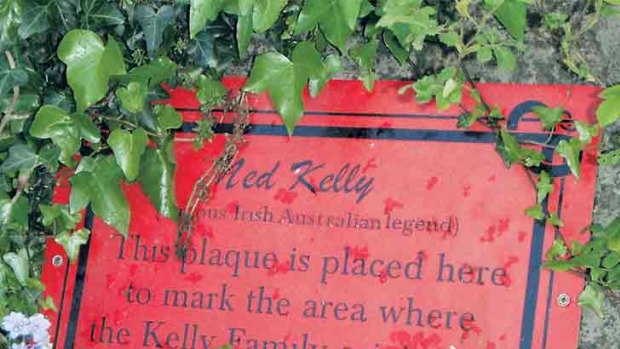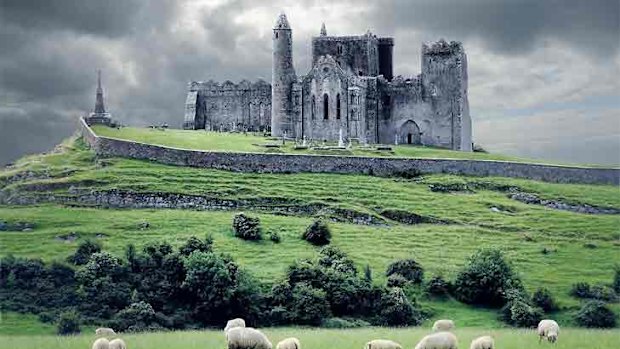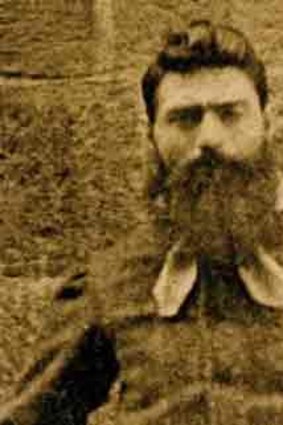
A plaque marks the site of the Kelly home in County Tipperary.
In Tipperary, Tim Richards follows the trail of John Kelly, petty thief and father of Ned.
'He was like all troublemakers - they were disenfranchised, angry young men with no jobs, no future at all, with no stake in society, they were the bottom of the pile," says Terry Cunningham, as we chat in McCarthy's Hotel, an atmospheric old pub in Fethard, deep in Ireland's County Tipperary. The particular angry young man we have in mind is John "Red" Kelly, a poor local tenant who stole two pigs in 1840 and was sentenced to transportation to Australia.
An inconsequential story, you might think, but after he did his time in Van Diemen's Land, Red moved to Victoria and married Ellen Quinn. Settling in the high country, he fathered a famous son - Ned Kelly.

The nearby Rock of Cashel in South Tipperary.
As we dispatch some Guinness, I ask Cunningham if the Irish know much about their bushranger descendant. In Australia, there is still debate about whether Ned was a crook or a hero, and was recently in the news once again as his bones were identified by DNA testing as being among those in a group of unmarked graves at Melbourne's former Pentridge Prison.
"We know he was an outlaw in Australia, that he was Irish and that he kicked a few arses," Cunningham says. "But we don't really know the story. The Mick Jagger film keeps turning up on television every five years, but that's it."
If his countrymen need educating about the Kelly saga, Cunningham's the man to do it. For several years the Fethard Historical Society, of which he's a member, has popularised the district's Australian connection. Its booklet on John Kelly details his local life before his abrupt 1841 relocation on behalf of Her Majesty.

Ned Kelly.
Cunningham also offers a driving tour of Kelly's haunts across a swath of pretty green Tipperary countryside. Not that there's any reason to hurry from Fethard. This attractive town of 1500 people was founded in about 1200 by a Norman lord installed by King John of England, and it is still encompassed by sturdy grey mediaeval stone walls, with traffic passing through its surviving North Gate.
From the banks of the Clashawley River below the town, there's a fine view of the tower of the Holy Trinity Church, one of several architectural remnants from the Middle Ages.
But we're on the trail of John Kelly, so we head into the countryside, driving through what seems like a typical slice of rural Ireland, right down to the narrow hedge-lined laneways separating properties. As we drive, Cunningham shares his theories about the temperaments of Anglo-Saxons and Celts. He also paints a picture of the John Kellys of the early 19th century, a landless class of casual labourers, working for big landowners and doing whatever it took to put bread on the family table. It was a time of violence and turmoil, he says, an image that's hard to reconcile with the peaceful landscape beyond the car window.
We pass Coolmore Stud, one of the places visited by Queen Elizabeth II on her first tour of Ireland. Further on, Cunningham points out a residence belonging to British composer Andrew Lloyd-Webber. Then we're pulling up in the tiny village of Moyglass and we're firmly on John Kelly's home turf.
Cunningham gestures towards the cemetery that once housed the church where Red was baptised, but it's the village pub that catches my attention. An attractive small building with a sloping shingled roof, the Ned Kelly Village Inn is a tribute to the bushranger. There's a depiction of Ned on a horse on the pub sign, and his bearded face appears on the wall below with his final words: "Such is life." The Kelly family tree is painted on a wall in the car park, next to an image of Ned wearing armour.
Nowadays the pub is open only in the evenings, but by chance the owner shows up while I'm taking photos and invites us inside. Glass-panelled doors push aside to reveal memorabilia describing the Kelly gang's history.
Leaving the pub, Cunningham navigates winding lanes to a rise from which we have a view of Slievenamon, "Mountain of the Women". The landmark is said to be where the legendary warrior Fionn Mac Cumhaill (known in English as Finn McCool) chose as his bride the fastest of a group of women who raced to its peak.
Then we locate a small plaque by the roadside, half-hidden by the abundant vegetation. It marks the field where John Kelly once lived, renting a small house. Afterwards, we pass the former police station in Dualla, where the owner of the stolen pigs reported the crime; and, finally, halt at the abandoned house at Ballysheehan where Kelly committed his theft.
It seems fitting to end the tour where Ned Kelly's story began - the impulsive act undertaken on this spot would see John Kelly transported halfway around the world and then father an Australian legend.
Alongside Cunningham's vivid discussion about the inequality of Kelly's day, it all makes for a fascinating way to wander through beautiful countryside
Back at McCarthy's (whose other sign reads "Publican, Restaurant, Undertaker"), I ask Cunningham whether he thinks Ned Kelly was a hero or a villain.
"I have sympathy for him," he says. "You shouldn't kill anyone, but I suppose he got in too deep so he was the one who got shot and hanged. It's like the problem with watching The Sopranos. They're killing people and stealing money and cutting up people, but you're undecided. It depends on what angle you're coming from."
Tim Richards travelled courtesy of Tourism Ireland.
On the trail of a bushranger
AT THE Australian end of the Kelly story, the Ned Kelly Touring Route traces the exploits of the Kelly Gang from Jerilderie in NSW through Victoria's high country. The route is a great way to liven up a drive between Sydney and Melbourne. Highlights include:
The siege site at Glenrowan where the Kelly story ended in a shootout with police.
Stringybark Creek, a lonely place where the gang shot three policemen in 1878, which then officially made them outlaws.
Benalla Pioneer Museum, which exhibits a green sash the 11-year old Ned was awarded for rescuing a drowning boy.
Benalla Cemetery, where gang member Joe Byrne is buried.
Mansfield Cemetery, which holds the graves of troopers killed by the Kelly Gang.
Jerilderie, where the gang robbed a bank and where Ned Kelly wrote his famous open letter to the authorities.
Beechworth, at whose courthouse Kelly was committed to stand trial. There's a daily Ned Kelly walk around the town's historic precinct.
See nedkellytouringroute.com.au.
FAST FACTS
Getting there Etihad flies to Dublin from Sydney and Melbourne for about $1925 low-season return including tax. You fly to Abu Dhabi (about 14hr), then to Dublin (8hr 30min); etihadairways.com. Another option is to fly to London Heathrow and connect with Aer Lingus, which has daily flights to Dublin; aerlingus.com. From the Irish capital it's a two-hour drive to Fethard.
Staying there Brooks Hotel, 59 Drury Street, Dublin, a short walk from the Grafton Street city centre, has double rooms from $170 a night; phone +353 1 670 4000, see brookshotel.ie. Hillhouse, at Palmershill, Cashel, about 15 kilometres from Fethard, has rooms with views of the mediaeval castle complex known as the Rock of Cashel, from $55 a night, phone +353 62 61277, see hillhousecashel.com.
Touring there Terry Cunningham's Kelly Tour is available by prior arrangement, fee negotiable; phone +353 86 390 5373, email terry@foodinseason.ie.
Sign up for the Traveller Deals newsletter
Get exclusive travel deals delivered straight to your inbox. Sign up now.